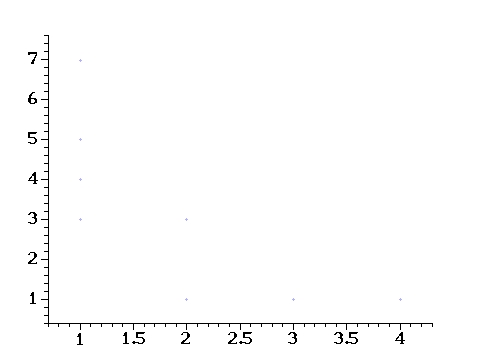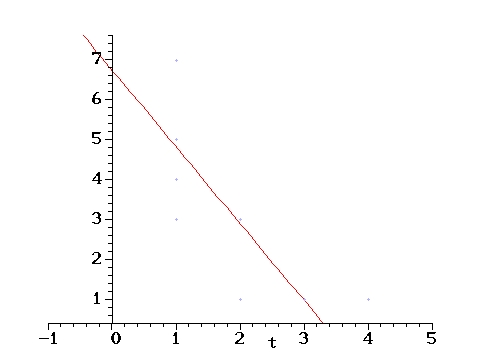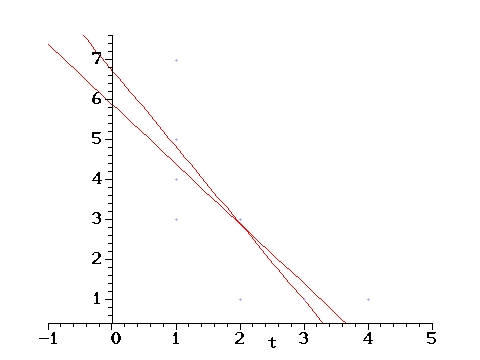Problem:In a (hypothetical) study on population growth, data on the percentage of kids of different ages is collected for 10 cities.
Age % of Population
__________________________
1 4
1 5
1 7
1 3
2 3
2 3
2 1
3 1
3 1
4 1
SOLUTIONS:First let's enter the data to the calculator. |
> with(stats): age := [1,1,1,1,2,2,2,3,3,4];
age := [1, 1, 1, 1, 2, 2, 2, 3, 3, 4]> ppop := [4,5,7,3,3,3,1,1,1,1];
ppop := [4, 5, 7, 3, 3, 3, 1, 1, 1, 1]> ave := dat -> stats[describe,mean](dat):
aveAge := 2
sdAge := 1
avepp := 2.9
sdpp := 1.92
> rAp := r(age,ppop);
rAp := - 0.78
> scatter:=(x,y) -> stats[statplots,scatterplot](x,y): 
|
|
Scatter plot with the SD line
> sdline := t -> 2.9 - 1.92*(t-2):
> l1 := plot(sdline(t),t= -1..5): scatt := scatter(age,ppop):
> with(plots):
> display({l1,scatt});

|
|
Both the SD and the Regression line
| Recall that the regression line is the line that minimizes the sum of the squeares of the residuals and it is also known as the line of least squares. |
> rl := plot(2.9 - 0.78*1.92*(t-2),t=-1..5):
> display({l1,rl,scatt});

|
|
The R.M.S. for % on Age
> RMS := sqrt(1 - 'r'^2)*SDy;
2 1/2
RMS := (1 - r ) SDy
| For our data this is: |
> RMS := sqrt(1. - 0.78^2)*1.92;
RMS := 1.2
|
|
When age = 3.5 the regression line predicts:
To get y from x using the regression line of y on x do:
|
> x_in_sus := (3.5 - ave(age))/sd(age);
x_in_sus := 1.5> y_in_sus := x_in_sus * r(age,ppop);
y_in_sus := -1.2> y_predicted := ave(ppop) + y_in_sus * sd(ppop);
y_predicted := 0.65
|
|
What proportion of the kids, who are 3.5 years of age, belong to cities with more than 1% of kids their age?
| Here we are looking only at 3.5 year olds. We use the fact that the list of y values (in this case pop. %) with a fix value of x (in this case age=3.5) follows the normal curve with an average given by the regression line (y when x=3.5) and an SD estimated by the R.M.S. error for the regression of y on x. Thus the question is: What proportion of the entries of a list that follows the normal curve with ave = 0.65 and SD= 1.2 is expected to be greater than 1? |
|
|
answer:
|
> a_in_sus := (1 - 0.65)/1.2;
a_in_sus := 0.29
The area under the normal curve to the right of 0.29
is computed from the area given on the table for z = 0.29
z Height Area z Height Area z Height Area ___________________ __________________ ___________________ 0.00 39.89 0.00 1.50 12.95 86.64 3.00 0.443 99.730 0.05 39.84 3.99 1.55 12.00 87.89 3.05 0.381 99.771 0.10 39.70 7.97 1.60 11.09 89.04 3.10 0.327 99.806 0.15 39.45 11.92 1.65 10.23 90.11 3.15 0.279 99.837 0.20 39.10 15.85 1.70 9.40 91.09 3.20 0.238 99.863 0.25 38.67 19.74 1.75 8.63 91.99 3.25 0.203 99.885 0.30 38.14 23.58 1.80 7.90 92.81 3.30 0.172 99.903 0.35 37.52 27.37 1.85 7.21 93.57 3.35 0.146 99.919 0.40 36.83 31.08 1.90 6.56 94.26 3.40 0.123 99.933 0.45 36.05 34.73 1.95 5.96 94.88 3.45 0.104 99.944Hence, the area between -0.29 and +0.29 is about 23.5% so the area outside this interval (both tails) is about 76.5% and the right tail is just half of this i.e. |
> Answer := (100 - 23.5)/2;
Answer := 38 %